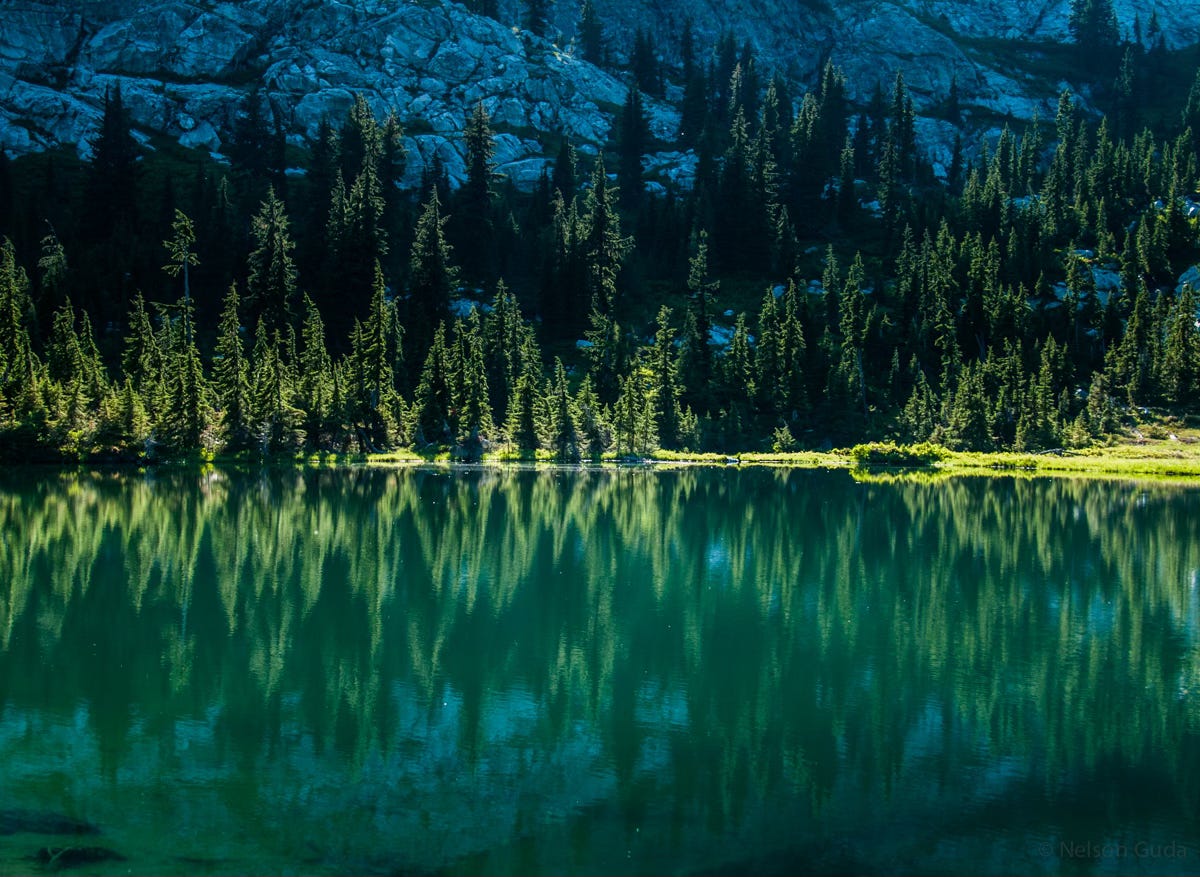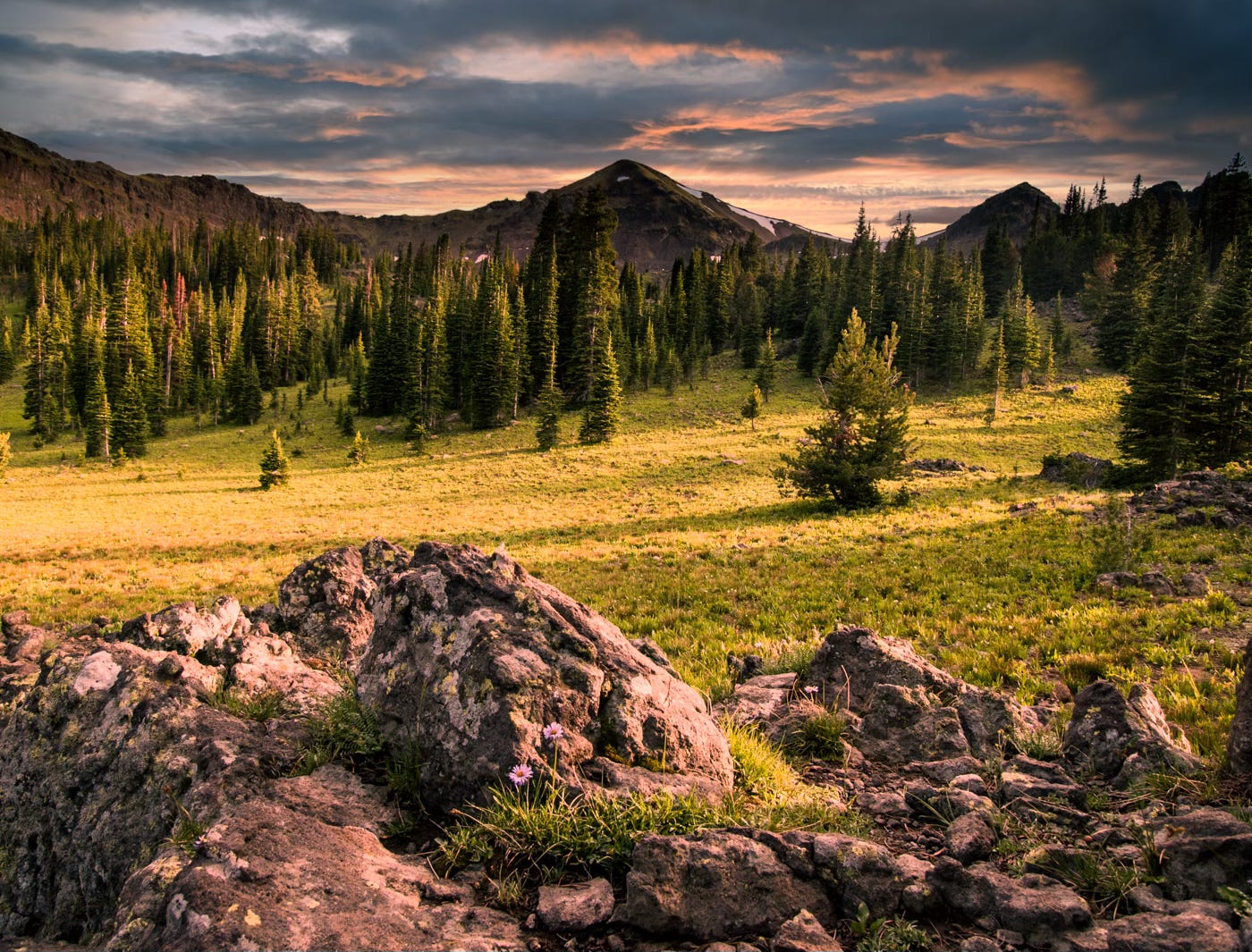Predators in Our Midst
What is the wilderness that calls in our hearts, minds and surroundings?
Predators in Our Midst
July 6, 2006, Falls Creek Valley, Pioneer Mountains, Idaho
It isn’t yet dawn. The birds are still asleep, and the wind is gently flapping the sides of my tent. Each of my breaths cloud the air in front of me. I can see nothing outside the screen, but I can hear the valley.
The last two days have been filled with rain, and I can hear the creek playing and laughing. In between the occasional flaps of the tent, the wind blows a slow symphony in the trees up and down the valley; a long, low sigh of a phrase – now rising, now falling – barely audible in the distance, touching the peaks, the pines, the fallen shale and the meadow beyond. It’s not a song of celebration or lament, not a dirge or a hymn, just the breath of the sky sung against the body of the land, but on this morning, in this valley it is sung for my ears only.
As I listen, something walks by my tent, gently disturbing the gravel. It is the slightest of sounds, like the barest wisp of cloud passing low to the ground on an overcast day. I hold my breath listening for something more, but there is nothing more to hear but the wind and the thudding of my pulse. The tent flaps gently, and I think about predators. A moment later there is a splashing. Then it is gone.
I wait for more footsteps, another splash, a sniff or snort, but the only thing I hear is the flapping of the tent, the whispered chorus of the wind and now the waking of birds. Whatever it was has moved along in silence without telling me or anyone else where it was going.
Imperceptibly, the sky is beginning take on color.
That journal entry is one of many from the Roadless Project, a project of mine that spanned nearly a decade.
For those of you who haven’t know me that long, the Roadless Project was a long and complicated affair. I spent years crisscrossing the country trying to photograph and map as much as possible of the fifty-nine million acres that the US Forest Service calls Inventoried Roadless Areas.
Over those years I met with, interviewed, ate steaks with, fished with, had coffee or beer with, and generally BS-ed with scores of people who were connected in some way to these incredibly important places. I also took numerous trips to DC to meet with legislators, and eventually I showed photographs and stories from the project in the US Senate building. All that seems like so long ago now, but I’m telling you about it because the current administration is trying to rescind the Roadless Rule that protects these places.
I’m not going to delve into a deep discussion about why these lands are important. I’ll save that for another time. Mainly I want to urge you to make a public comment to voice your opinion about saving these lands. That link leads to a form supported by Environment America that will send your opinion to Secretary Rollins.
At the end of the Roadless Project I wrote most of a book, which has yet to be published. The journal entry above is the beginning of a chapter titled “Predators in Our Midst.” Nowadays, I feel that this could be an appropriate title for a letter about our current politics, but I’ll also save that for another day.
Anyway, the potential gutting of the Roadless Rule is an especially painful thing for me. The book I did not finish is filled with personal stories of my time exploring these quietly beautiful places, stories of the people I met along the way and stories about the land itself. The time I spent in these lands changed me as much as anything else in my life has changed me. It shaped my perception not only of myself, but also of our crazy and diverse country.
Looking back, as polarizing as that first decade of this century seemed at the time, it feels quaint compared to the divisions we are currently facing. I spent so much time talking with loggers, ranchers, hunters, fishermen… and now I wonder if any of those conversations would be possible at all in today’s tense and fractured climate.
So, I'm going to end this post with a few more paragraphs from that chapter which eventually talks about the loss of a pack of wolves in the northern Rockies. It is unedited, still fresh from the first draft over a decade ago. I hope you can enjoy it and perhaps reflect upon the wilderness that surrounds us – that which is gone, that which is still here to be saved, and that which breathes inside the heart of all people.
Predators in Our Midst (continued)
I had hiked into Fall Creek Valley at the end of the previous afternoon and set up my tent on a small gravel bar alongside the creek. I knew that there were wolves in the Pioneer Mountains, and I had been hoping that I would see or hear them. When I first heard the footsteps outside my tent I jerked my head up quickly. My heart raced as I had strained to catch another sound, and even though I realized right away that the footfalls were too small to be wolves, it took several minutes before my pulse slowed.
The Pioneer Mountains of south-central Idaho are part of a large stretch of Inventoried Roadless Areas that surround the Sawtooth Wilderness east of Boise. Standing like sentinels over the vast plains of the lower Snake River, the Pioneers contain places that would rival Yellowstone National Park if they had fewer cattle. Surprise Valley sits in one of these areas. It is a secluded valley in a patch of mountains just over a sky-rending ridge from an eight-mile long, four-mile wide valley known as Copper Basin. The sides of Copper Basin are Inventoried Roadless Area. It is reminiscent of Yellowstone’s famous Lamar Valley, where re-introduced wolf packs have flourished in sight of a main road through the park.
After I woke to footsteps on the edge of Fall Creek, I stayed up and readied myself to hike up to Surprise Valley. For a couple hours I climbed through a boulder strewn forest of twisted pines, pulling myself up with my hands as much as my feet until my shoulders were tarred with sap from scraping through narrow spaces between tree and boulder.
When I got to the top I clambered onto a narrow ridge of bare rock, hanging a couple thousand feet above the valley – a river of pines flowing down a U-shaped cut in the rock between jagged snow crested ridges. I was alone with the clouds and the sweet scent of pine sap looking down on a pair of red-tailed hawks circling over the valley. A few feet to my right a few songbirds quarreled over a berry laden bush at the edge of a cliff.
I sat on that spot for a long time watching as the toothy ridges of Falls Creek tore the clouds into bits and tossed them over the valley like scraps of a discarded kill. Beyond the jaws of the valley, or maybe within it, a pack of wolves was sleeping or hunting in a place where wolves had been killed off a century earlier.
This was the wilderness that I need to know about when I fall asleep in the city.
Even when I am not there, I need to know that this type of place still exists. I think this is something that we all need, the knowledge that there are places out there that are still wild. Without these wild places, the only wilderness we know is that of our own making, the wilderness defined by our crimes against each other. We need places beyond our control and at the edge of our imaginings that can be both dangerous and beautiful – the untamed source of life. It is why we grow up listening to stories about wild places and why we watch nature documentaries on television. These places are the source of what we are. And even if it is a shadow of what it once was, we need to know that some of that source is still there.
Words, Pictures and Memories
Unfortunately I don’t have a photograph from the spot that I describe in this piece – the photo at the top of the post is from a roadless area in northern Idaho and the one below is from another roadless area in Montana.
Over the many years that I was photographing these lands, there were a few times when I felt like I needed to set aside my camera and just absorb. During most of those times I wrote. But sometimes I just listened. If I miss anything from those years, it is the ever changing conversations of the earth told through the whispers, discussions and musings of the wind and rain, leaves and rocks, rivulets and rapids that cling to our fragile home.
One last thought - I’d love to have you join my community of first readers for A Cat in Sancerre. I released it on Kickstarter a couple weeks ago, and it is fully funded. Please join me – I think you will enjoy it in these trying times.




